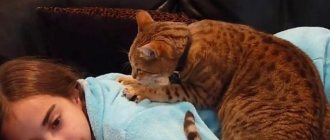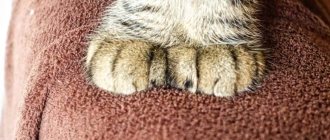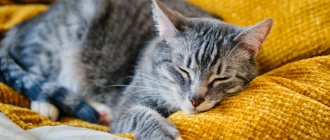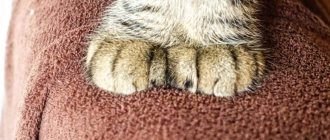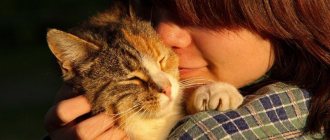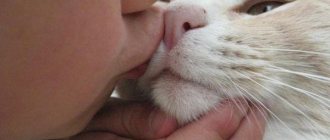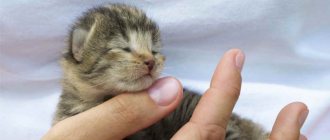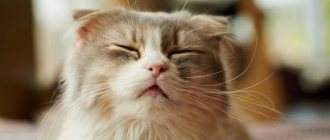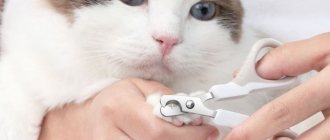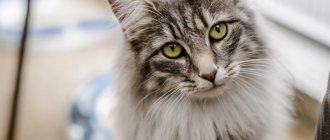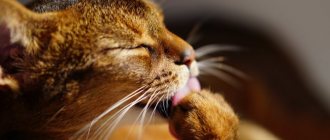Very often, owners of furry pets notice that a cat crumples a blanket, bed or human body with its paws. Sometimes this happens before they are about to lie down or after eating. Not all owners understand why cats knead the blanket with their paws and purr. And there are at least eight different reasons for this, which can tell a lot about the character of the pet. Read more about why this happens and what effect it has on a person below. After this, you will begin to appreciate the cat’s attention more and even learn to take advantage of the benefits of such a massage.
A little about cat physiology and the reasons for this behavior
These creatures differ from other animals in that they have a highly developed sense of touch. Whiskers, eyebrows, paws are areas that expand the perception of the world. There are many receptors and glands on the pads, the whiskers play the role of an indicator of the emotional state, and vary in shape, depending on the breed.
Read also: TOP games on Instagram (story posts)
Cats tend to stomp around in one place, moving their paws as if kneading dough, sometimes releasing their claws, accompanied by purring. This movement is called the “milk step”. These tender expressions of affection apply to humans or other animals as well as to inanimate objects.
Psychological release
Pets experience stress associated with lack of attention, a trip to the veterinarian, a new neighbor and other reasons. Offended or upset cats relieve tension through a release ritual - they trample furniture, extending their claws, or knead a soft blanket or pillow with their paws. During such therapy, the animal releases endorphins, which helps it calm down. If you interfere, it may bite your hand.
Read also: Gift for 50th anniversary
Childhood memories
This instinctive movement of the paws in kittens is one of the first, appearing at birth. Babies, nudging into the cat’s belly and massaging it, stimulate milk production. Animals associate feeding time only with positive emotions. They remember how warm and cozy it was next to their mother. Having reached adulthood, feeling full and safe, pets involuntarily reproduce movements from childhood, shifting a blanket or sofa.
Preparation for sleep
Another cat instinct is related to preparing a place to sleep. In their natural environment, animals trample, crushing grass and leaves to prepare a bed. According to some animal psychologists, this instinct has survived to this day, but only in a number of pets. Therefore, the pet tramples the already soft pillow with its front paws before going to bed.
Mating season
The time of mating also forces the darlings to perform this simple action. Estrus is a period of sexual arousal that is extremely difficult to confuse with something else, since the cat begins to actively knead the blanket, arch its back, and move its hind legs, accompanying this with an expressive meow.
Best answers
Prince:
Your furry little one has awakened his childhood memories. After all, it was when your cat was a kitten that she trampled on her mother’s tummy to better simulate milk. Yes, this is exactly what young kittens do when their nurse's milk flow is weak. So, the cat’s usual “stomping” is associated with its childhood memories
At this moment, it is very important not to drive away your furry pet, but to let him trample, calmly stroke and caress him. Otherwise, it will be upset and may harbor a grudge against you.
Applo_o:
He sharpens his claws, soon it will come to the sofa :)
Anna Koryagina:
I think this is their nirvana point. Mine is like that too... Maybe she remembers when she was a kitten.
Daniella:
With happiness;) When they purr they are happy.
Anna Minakova:
She thinks it’s a scratching post, if you’re under the blanket, then she’s giving you a massage))
Suslov Evgeniy:
This is how kittens suckle their mother. It's just an expression of affection.
Ekaterina L A:
it’s called a milk step, he remembers how he crushed his mother in childhood and is delighted
Probable Causes
Experts in the field of animal psychology identify several reasons why cats knead their paws. This ritual has the following explanations and theories:
- Memory of childhood. A newborn baby, feeding on mother's milk, kneads the mother's mammary glands with its paws. This massage stimulates milk production, which is important when the cat has more than one baby. At the same time, feeding itself causes positive emotions in the pet. Having matured, many kittens perceive their caring owners as their cat mother. Having transferred their pleasant childhood memories to humans, young animals settle down next to their beloved owner and begin to touch their paws.
It is for this reason that cat breeders call this ritual the “milk step.” Owners often notice that the kitten not only wiggles its paws, but also purrs contentedly and even drools with pleasure. This theory is supported by the fact that artificially fed pets are not capable of the “milk step”.
- One of the reasons why cats paw is their natural instincts. Being once wild predators, animals carefully prepared places for rest and overnight: they trampled down hard grass, making the nest cozy and soft. In the wild, representatives of the cat family use grass and leaves to make a nest. To make your sleeping area comfortable and safe, it needs to be put in order. The most convenient way to do this is to crush objects with your paws.
The desire to equip one’s territory, a place to rest and sleep, is also characteristic of modern domestic couch potatoes. And although most pets live in comfortable conditions, nevertheless, they have not lost the ancient instinct of their wild ancestors. In addition, the cat often crushes soft objects with its paws, arranging a nest for birth and future offspring. Often this behavior is a sign of impending labor.
- Hunting instinct. Some experts believe that domestic cats knead a soft surface, obeying the ancient hunting instinct. Predators by nature, pets have not lost the ancient skills of this skill. Their wild counterparts, before jumping on the prey, crush the surface with their paws, testing it for stability and hardness. It is important for a predator that at a crucial moment a branch does not snap under its paw. Fluffy couch potatoes have not lost their natural instincts, but they do not always use them for their intended purpose.
- Territorial version. Some zoologists are inclined to believe that the reason why cats crush their owners' paws is their desire to mark their territory. There are specific glands on the pads of cats' paws, with the help of which they identify their possessions and territory.
Considering its beloved owner to be its property, the animal leaves its scent on his body, making it clear to other individuals that they can no longer have the right to the owner’s attention. Thus, the ritual serves as a kind of marker to mark one’s property and possessions.
- Psychological release. The psycho-emotional tension or stress accumulated by the pet requires release. Some animal psychologists, not without reason, believe that the reason why cats knead the blanket with their paws is self-soothing. At the same time, the animal practically disconnects from the outside world and focuses on its internal sensations. Monotonous paw movements and purring help calm the pet.
This point of view is supported by the fact that during the “milk step” the cat’s body produces endorphins - specific substances, hormones of happiness. They reduce anxiety and fear in pets.
- Other factors. Experienced breeders believe that the reason for the cat ritual is a high degree of trust and love for its owner. Many cat fans believe that animals perform such a ritual for a healing purpose - they treat their owner from various ailments, taking away negative energy.
Another reason why cats massage their paws is sexual behavior. As a rule, in the spring, with increasing daylight hours, the production of sex hormones increases, which in some individuals is accompanied by a “milk step”. The variety of theories, versions and guesses regarding a peculiar ritual inherent only to representatives of the feline family once again testifies to the mystery and enigma of domestic cats.
None And here is more information about how to remove a cat from a tree yourself and with the help of special services.
[custom_ads_shortcode2]
Possessive habits
Why does a cat bite its owner's legs?
Cat lovers don't like this theory at all, but it has a right to exist. Between the toes of cats there are tiny glands that secrete a specific substance. With the help of this odorous substance, the cat leaves marks that a person cannot feel. One of the likely reasons why cats trample on a person is the desire to leave their scent on him, to “stake out” the owner, declaring their rights. It is curious that, as a rule, insecure, affectionate and dependent cats trample, which partially confirms the theory: by leaving scent marks, the cat feels calmer and less susceptible to stress.
Unconfirmed assumptions
The remaining reasons are considered unconfirmed assumptions. They also explain why cats knead their paws, but they have some nuances that do not allow them to be classified as the main ones.
Marking territory
The sweat glands of mustachioed pets are located directly on the pads of their paws, so in the heat they leave wet marks on the tiles. In addition to cooling the body, the enzymes released help repel uninvited guests. This feature is actively used for marking territories. Most often, females resort to it, since males spray an odorous secretion when urinating.
When marking territory, cats practically do not trample, but simply scratch with their paws. Unlike regular kneading, such touches increase the coverage area and increase the security of the territory.
Hunting
If we consider all possible reasons, then it makes sense to note the hunting instinct. He explains why cats crush the surface with their hind paws before attacking. In this case, this movement helps to ensure safety: the absence of noisy leaves and too soft soil under the paws in which you can get stuck.
Despite the fact that in most domestic animals the role of prey is played by a toy mouse, and the role of soil is a stable laminate, the habit inherited from wild ancestors is still preserved.
Host treatment
Cats love warmth, so they can sense inflammation a mile away and prefer to “heal” their owners. In fact, they simply settle down on the warmest and softest place possible, massaging it before curling up into a ball.
Vibrations during purring really have a beneficial effect on health, but the removal of negative energy and the miraculous treatment of diseases with their help is just a myth. If after a cat massage your mood and well-being improve, then it is important to understand that “after” does not mean “as a result.” Most often, these problems are solved by banal rest and taking medications.
Stress relief
The last unconfirmed hypothesis explaining why cats paw is associated with endorphin, the pleasure hormone. Cat pads are equipped with many receptors responsible for the sense of touch. Trampling soft and pleasant to the touch surfaces stimulates the production of endorphins, reducing stress levels.
Because of this, many pets wrinkle the blanket after returning from the veterinarian or a recent punishment for stealing sausages. At such moments it is better not to touch them, since before the steam is completely released they can take out their dissatisfaction on your hand.
Therapeutic effects on humans
According to professional breeders, pets are capable of healing. This theory is partly true. It has been scientifically proven that they can help a person.
Treatment with cats or feline therapy is a therapeutic technique that anyone can resort to if they are not allergic to wool. Cats are able to sense the owner’s mood; if treated gently, he will come to the rescue when you need to relieve tension.
In addition to the fact that cats help you feel better, their purring calms the human nervous system.
However, rumbling has another function - thickening the bones. Pets use it to heal fractures, since the frequency of sound vibrations from 20 to 50 Hz has a positive effect on bone tissue.
Doctors recommend communication with cats for people diagnosed with schizophrenia, cerebral palsy, and autism. Regular communication will help in socialization of children, becoming a good friend. The care shown by pets normalizes the human condition.
Selecting a territory
It is believed that the sweat glands on the paw pads of cats are involved in the process of identifying territory. The chemical composition of secretions in all living organisms, including humans, is unique to each individual. Animals can indeed communicate in this way what belongs to them. This is an instinctive process and it occurs spontaneously: a signal is recorded in the pet’s brain about the need to mark the territory. The favorite is reminded of this by the most ancient mental attitudes.
If a cat tramples a person with its paws, this means that the animal appreciates him and wants the owner to always be with him.
When the phenomenon is observed
The owner most often observes the peculiar behavior of a domestic cat when the animal is in a peaceful and calm state. At this moment, the pet may purr. Some cats perform the ritual without releasing their claws. Other individuals can crush the soft surface, extending their claws to their full length.
Many cat breeders note that the cat ritual usually takes place on a soft and pliable surface: a blanket, a mattress, the owner’s lap. A hard surface is not suitable for such purposes. Often the “milk step” is used in relation to a soft toy.
Most often, a cat crushes a soft object with its paws when it is about to rest or sleep. Expectant mothers begin to prepare the nest for childbirth and offspring, often before an important event they begin to knead the blanket with their paws. Pets love to perform such a mysterious action when they are on the lap of their beloved owner. Fans of cats note that a cat performs such a ritual only with its owner; such affection is not available to a stranger.
Showing love and affection
But it’s not just the desire for control that animals express in this way. Cats often place their paws on top of their hands when they are overwhelmed with feelings of tenderness, affection and love.
Animals whose owners are away from home for a long time especially often express their affection in this way and caress people. Cats left alone for a long period of time begin to feel bored and melancholy. And by placing their paws on top of a person’s hands or on a person’s face, the animals try to keep the owner close to them and receive as much attention and affection from him as possible.
Kittens up to a month old
It is strictly not recommended to adopt a kitten that is less than a month old. At this age the pet:
- cannot develop properly without mother's milk;
- needs survival lessons from mom;
- unable to independently understand the environment.
Mother cat, together with breast milk, provides babies with a complete supply of micro- and macroelements necessary for development and strengthening the immune system. No artificial nutrition can be a high-quality replacement for natural food. In addition, kittens that are among brothers and sisters next to their mother receive their first important skills. Before a month, babies do not have time to learn all the necessary lessons. The presence of a cat makes it easier for kittens to get used to the tray and complementary foods.
Owner behavior
When cats mark time, they often release their claws from their paws. The person with such a playful pet can be very unpleasant from his actions. In addition, the animal can damage bedding, upholstered furniture, blankets, rugs, etc.
If an animal is scolded and kicked out of the premises, it will not be able to understand why exactly the owner was indignant. At the same time, the cat will harbor a feeling of resentment and will gradually become alienated from the person.
To stop your cat from scratching, you can use the following methods:
- Gently stroking the paws. If you start stroking the paws of a pet that is trampling, this manipulation forces him to remove his claws and continue the “massage” with pads. If the owner does this every time, the animal will get used to it and stop releasing its claws.
- Laying down. If the cat begins to trample and releases its claws, at this moment you need to start stroking it more intensely and lay it on its side. This is a safe way to stop scratching.
- Abstraction. To do this, it is enough to suddenly change the nature of the stroking, as a result of which the cat will stop for a while, and when it resumes, it will no longer release its claws.
Owners of cats must take into account that trampling is a kind of ritual through which the animal demonstrates its trust and affection.
Massotherapy
Surprisingly, cats can not only relieve stress, but also give you a soft and pleasant massage with their paws. What does it mean when a cat kneads its paws - it is simply trying to thank you for a delicious dinner or for showing concern for it. The therapeutic effect comes not only from the cat massaging different parts of the body, but also from its purring during the process itself.
This helps a person to rest and relax after a difficult day. Some owners, for the sake of cat trampling, are ready to endure “accidental scratches” that they may accidentally receive during a massage.
Establishment of “ownership rights” to the owner or mistress
If a cat crushes a person with its paws, this probably means that this is how he establishes his rights to him. The fact is that on the pads of a cat's paws there are sweat glands, with the help of secretions from which these animals leave odorous marks. The beloved owner becomes an object protected by the cat from those who wish to encroach on him. Being marked as a pet is a special honor, because from now on he will give all the affection and love to the one to whom he has established ownership.
[custom_ads_shortcode1]
Dancing under the moon
They say that during the mating season, cats dance in front of their chosen one: a female in love shows her “step”. I didn’t have to learn and show my dancing talent - they sterilized me early, but in return they offered me smart clothes. I showed off in it: I understood and forgave people. What to take from them. Everything that is done is for the better. Life goes on...
My home friend spoils me in every possible way, takes care of me and loves me. I feel my master’s love with every fiber of my soul, so I don’t hold any grudges.
Mechanism
How does a cat’s “purr” work, and what is it anyway? Have you ever wondered how kittens create this sound and why people like it so much? There are several theories about the origin of purring.
Vocal cords
Taking a closer look at your animal, you will probably think that the tummy makes a continuous sound. But that's not true. There is an opinion that a cat purrs precisely through the vocal cords, but the process “starts” in the cerebral cortex. The muscles of the larynx, at the behest of the animal, begin to vibrate sweetly and emit a soothing and pleasing purr (or, conversely, the battle cry of meowing).
Diaphragm
Scientists also believe that purring sounds come from the diaphragm or, more simply, from the lungs. That is, they are provoked by vibrations in the cat’s lungs. Experts think this because the cat purrs in time with its breathing. This set the stage for thought.
Vascular theory
The vascular theory states that the “clattering” occurs due to the pressure created in the cat's body by the blood circulation. Under the influence of certain emotions, the pressure difference causes the chest to vibrate and the cat makes the very sounds that we hear and call “purring.”
These are mysterious animals! And yet, scientists have solved the mystery! The vibration spreading throughout the body comes from the hyoid bones. They are located between the base of the skull and the base of the tongue of animals.
Reference! It is because of the contraction of the muscles of the vocal cords that vibration occurs, accompanied by pleasant purring sounds.
Results
Cats are very sweet pets, whose presence in the house can bring real joy to their owner. You need to understand that sharpening its claws is a natural behavior of any cat, so you should not scold it for such actions. If you don’t like this cat’s “activity,” simply switch the cat’s attention to another object or toy. Treat your pet kindly, and he will definitely reciprocate you with love.
More from my site
- Is it possible to give a cat vegetables? What vegetables can cats eat? According to experts, it is definitely not only possible, but also necessary to maintain nutritional balance. For the health and good mood of your pet, it helps […]
- The cat began to mark - what to do At what age do cats begin to mark their territory, what to do and how to fix it. The situation becomes tense for all residents after being tagged due to the unpleasant odor. You shouldn’t immediately [...]
- A cat yells at night - what to do How to stop a cat from yelling at night, since these sounds will certainly not allow you to live in peace. The well-being of its owner depends on the balance of the tail. This behavior can happen […]
- Cat diseases Cat diseases, symptoms are what owners of furry creatures often encounter. The presented table and treatment, which you will find in the article, will help you identify cat diseases […]
- Calcivirosis in cats, treatment and consequences Calcivirosis in cats is an acute infectious disease that is widespread among all cat breeds, especially affecting unvaccinated ones. The disease cannot pass to a person, but [...]
- The Balinese cat is a graceful breed of cat. The Balinese cat was born at the beginning of the 20th century. The breed is a semi-long-haired cat with a non-standard color. Balinese or Balinese is very accessible in content, without […]
- Oncilla - an unusual breed of cat The oncilla cat is a unique animal of the cat family, living in the vastness of Central and South America, Argentina, Brazil, Colombia and Costa Rica. Cats of this breed today [...]
- Chocolate Burmese Cat A Burmese cat with an unusual appearance and short, shiny fur, reminiscent of a smooth chocolate bar. Surprisingly, with a stern look in their eyes, these cats are flexible and [...]
- How often can you wash a cat? How to wash a cat when most people don’t like to take baths. The question remains relevant even when the furry is a homebody and does not often walk outside. If you teach a cat to swim with [...]
Why does a cat purr?
The reasons for rumbling in cats can be very different. Let's look at the most likely and common of them.
- Pleasure and tranquility - the cat is calm, relaxed, full and satisfied, nothing bothers him.
- Communication between mother and kittens - newborn kittens are blind and do not yet know how to communicate by meowing. By purring, the mother lets the babies know that they are safe, and the children show her that they feel good.
- The pet wants to show love and devotion - for the cat this is a gesture of trust, it establishes a kind of connection with a loved one. And after a pleasant game or a delicious meal, he can show gratitude in this way.
- He wants to get something - it could be some kind of treat, a favorite toy, or just affection and attention.
- Preparing for sleep - while purring, cats calm down and relax, sleep will be stronger and sweeter.
- Pain relief – cats may purr if they are injured or sick. A signal is sent to the brain centers of the brain and pain is reduced due to the release of endorphins.
- Presence of disease - purring too often and for a long time may indicate the presence of diseases in the pet. For example, this is one of the symptoms of feline infectious peritonitis.
- Communication with other animals – some cats purr and show interest and friendliness towards other animals. Males may purr around other, older or weaker cats. This is how they show that they will not attack.
- Anxiety and fear - the animal may be worried about an important event or something is bothering it, for example, the appearance of a stranger in the house.
Reference! Some cats purr during labor to calm themselves down and relieve pain.
Cat therapy
When a kitten crushes objects or a person with its paws, it also has a beneficial therapeutic effect on its owner - it gives him its energy and takes away bad mood, depression, fatigue and negativity. In alternative medicine, it is known that massage with a cat has healing powers.
In some situations, this technique is even specifically used:
- Cats can alleviate negative symptoms for people with autism, cerebral palsy, or people with various disabilities.
- Sometimes these pets are able to help a person get rid of chronic diseases through a strong energy field.
- Cats can ease symptoms after inflammatory processes or reduce post-operative manifestations.
- People who have cats in their homes are less susceptible to viral and infectious diseases.
- Cat energy can help heal bone fractures.
- The purring of your pet will calm you down after a hard, busy day, help you overcome stress and strengthen your nervous system.
Cats also have unique intuitive feelings - they try to be alone with their owner if they feel that he is feeling bad or is very upset. If a person has pain in some place, the cat can lie down on the painful area. It is believed that cats sense the approaching death of their owner, so when this occurs they try to be close to him.
Such incredible qualities of pets should be appreciated, responding to them with love and care for their affection towards the owner.
How to behave as an owner
While a cat is kneading the human body with its paws, the owner of the animal does not feel entirely comfortable due to the fact that he forgets himself and releases his claws. This, in turn, can bring a feeling of pain, both mild and quite strong.
Under no circumstances should you scold a cat, much less hit it. A loud, menacing voice or a harsh slap can cause misunderstanding and mistrust in a cat. She may begin to avoid the person and become aggressive towards him. Indeed, at the time when an animal tramples its paws on something, it experiences the most tender feelings.
However, you should not endure the pain from claws when in contact with a cat, nor should you turn a blind eye to the fact that the animal can ruin your interior items. The following actions will help minimize the negative consequences of paw trampling:
- Start gently stroking your pet’s paws; after a couple of minutes, the animal will remove its claws, continuing to stomp only on the pads;
- Start stroking your pet more intensively, and then gently lay it on its side;
- Distract your cat from what she is doing. Play with her or hug her.
Having considered the possible reasons why cats begin to knead a person’s body or interior items with their paws, we can see that in the vast majority of cases the animal does not do this because it experiences negative emotions. On the contrary, this is how the pet prepares for rest or shows a trusting attitude towards the owner.
The benefits of being friends with a cat
Friendship with your pet cat can be not only pleasant, but also mutually beneficial, since the owner receives many pleasant bonuses in return:
- When you pet a cat, you get the same pleasure as the pet, since these actions can seriously reduce the stress accumulated during the day.
- A long-term friendship with a cat will relieve the owner from prolonged depression, because every evening the cat will help relieve tension.
- People who keep a cat at home do not feel loneliness as clearly, which is why lonely people are more likely to have pets.
- Even conversations with your favorite cat can provide psychological help to a person.
- The rumbling and warmth of a cat's body can create comfortable conditions for influencing human sore spots and reduce the symptoms of various diseases.
- A cat massage is sure to bring you pleasure and relaxation.
